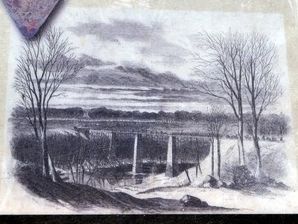L&N Railroad Bridge
By 1857, the Louisville & Nashville Railroad lacked only one connection for through trains to travel between the two cities—a bridge over Green River. Irish stonecutters John W. Key and sons were hired for two years to construct the piers that uphold the bridge, and German immigrant engineer Albert Fink designed and built one of his patented trusses. In its day, this bridge was the largest iron bridge in the United States, at 1,075 feet long.
The bridge’s true importance became evident in 1861, as the armies of the Union and Confederacy sought control of the vital rail lines. This railroad bridge was the link that could draw northern forces south. In an odd turn of fate, in August 1861 when General Simon Bolivar Buckner received instructions to destroy the bridge, the Keys, who had joined Buckner’s rebel force, were detailed to set and blow the charges, dropping two spans into the river to prevent the Union from using the bridge.
Three battles and five years of continuous military occupation followed, all for defense of the bridge. But the war would end, and trains would continue, and the stone piers that bore witness to the conflict still support the bridge today.
(Left Illustration Caption)
Albert Fink, a German immigrant and civil engineer, devised a type of bridge truss known as the “Fink Truss,” a patent design of overlapping wrought-iron king-post trusses with additional diagonal bracing. The piers are constructed of locally quarried limestone.
(Center Image Caption)
Plumb-bob used by John W. Keys and sons in building the bridge piers.
(Right Illustration Caption)
During occupation, armies would lay floors across the bridge’s rails to allow men, horses and wagons to cross in great numbers.









